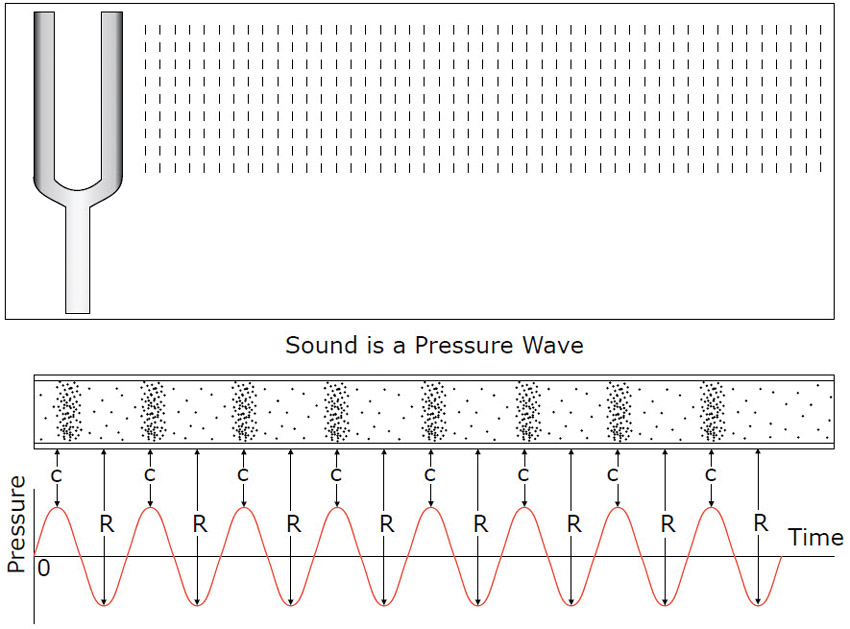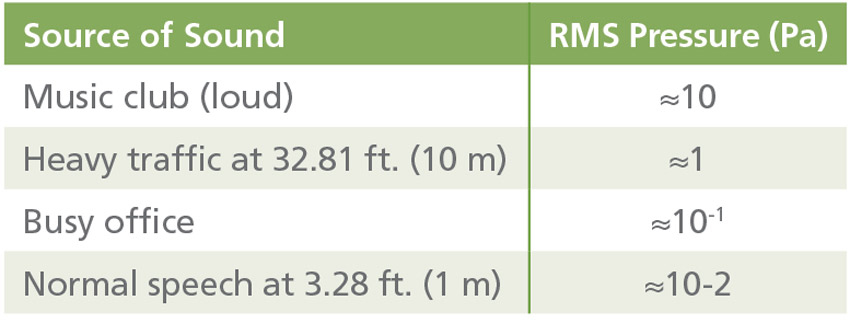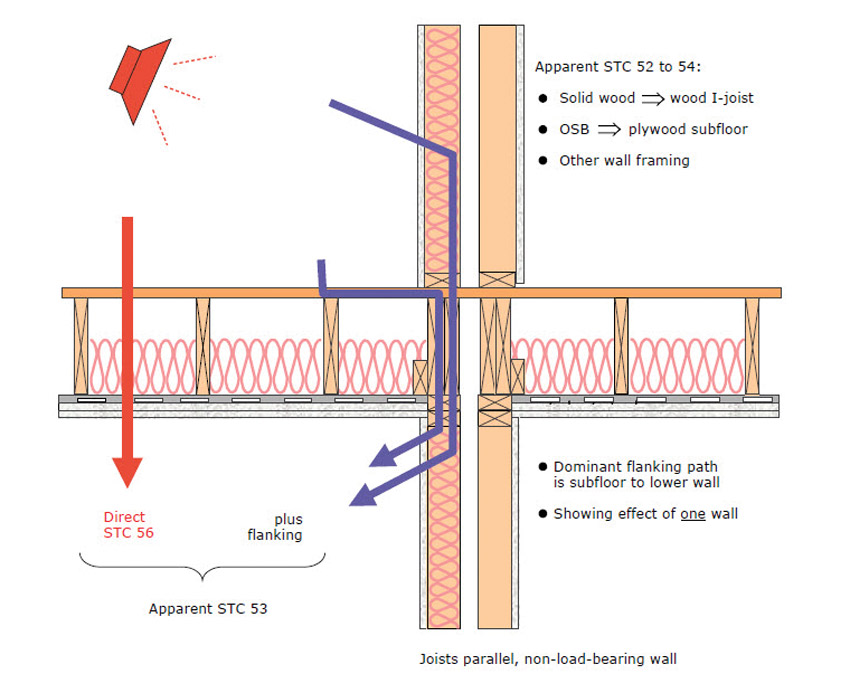Optimizing Acoustic Performance of Wood Buildings
Factors Affecting Acoustics
Environmental vs. Architectural Noise
There are two types of noise: environmental and architectural. Sources of environmental noise include automobiles, locomotives, rail cars, jet aircraft, industrial sources, telecommunications equipment, entertainment and construction vibration. The impacts of environmental noise include sleep disturbance, speech interference, occupant annoyance, reduced worker productivity, and prolonged patient recovery in health-care settings. Environmental noise can be controlled through measures such as noise barriers, sound-rated walls, and sound-rated windows. Building codes dictate different land-use categories that each have varying levels of acceptable exterior noise exposure, measured in decibels (the levels are Normally Acceptable, Conditionally Acceptable, and Unacceptable).

Source: US CLT Handbook
Simplified illustration of sound (pressure wave) propagation through air/solid structure (Kappagantu, 2010). In this figure, C signifies regions of compression, and R signifies regions of rarefaction of the air molecules. Furthermore, the “0” pressure line in the graph represents the atmospheric pressure level.
Land-use categories are categorized as:
- Residential, Hotels, and Motels
- Outdoor Sport and Recreation
- Schools, Libraries, and Museums
- Auditoriums, Concert Halls, and Amphitheaters
- Industrial, Manufacturing, Utilities, and Agriculture
Land uses where people live and work have more stringent codes and standards for acceptable noise exposure than uses such as stadiums and manufacturing plants.
Architectural noise includes environmental noise but also mechanical/equipment noise, structural vibration, and room acoustics, which can affect occupants in all building types, including health care, schools, institutional/commercial, residential, performing arts, civic, and industrial. The practice of architectural acoustics attempts to achieve good speech intelligibility, improve privacy, enhance the quality of performances in studios or venues, and suppress noise to make schools, offices, and residences more productive and pleasant places to work and live. This can be achieved by carefully specifying and detailing each building element and system to ensure the materials used work well together acoustically. Because of the complicated nature of this practice, architectural acoustic design is often performed by acoustic consultants in tandem with the rest of the design team.

Source: US CLT Handbook
Sound generated by various sources and their pressure (Pope, 2003).
Airborne vs. Impact Sound
Transfer of sound between adjacent spaces takes two forms. The first is the transfer of airborne sound, such as speech or music. In airborne noise, the medium carrying the sound energy is air. The ability for a building element such as a wall or floor/ceiling to prevent the transfer of airborne sound is measured by STC ratings. The second form is the transfer of impact sound, such as footfall. Impact sound is often more disruptive than airborne sound. For example, if a residential building is constructed of concrete, an 8-inch slab will effectively block the sound of voices from the suite above, but the sharp reports of someone walking in hard-soled shoes will be clearly audible. In contrast, it has been observed that very stiff wood-joisted floor/ceiling assemblies present greater low-frequency impact sound insulation. The ability of a floor/ceiling assembly to prevent the transfer of impact sound is measured by IIC ratings. Designers should determine the most appropriate rating to satisfy codes, regulations, and owner requirements.

Source: US CLT Handbook
Floor surface as flanking path (IRC, 2002). The red arrow indicates the direct path, and the blue arrows indicate the flanking path.
Acoustical Codes and Wood Buildings
The International Building Code (IBC) provides the minimum requirements for sound insulation of demising walls and floor/ceiling assemblies between adjacent dwelling units or between dwelling units and public areas, such as halls, corridors, stairs, or service areas. In residential buildings, the IBC provides a minimum design requirement for unit-to-unit acoustical protection between floors. It requires an STC rating or IIC rating of 50, unless the authority having jurisdiction has its own more stringent requirement. The International Residential Code (IRC) has an appendix that provides for a minimum design separation of STC 45 for townhouses, where specifically adopted by the authority having jurisdiction. This minimum requirement is the same for entry-level housing, market-rate housing, and luxury housing, whether it is dorms, apartments, or condominiums. Beyond that, it is the responsibility of the design team to develop an acoustical design that meets owner/developer/tenant expectations for the project.
In a mixed-use project, consideration must be given to the acoustics between all of the adjacent spaces—not just dwelling unit to dwelling unit. Acoustical separation between residential and other occupancies can be a significant challenge, and this condition is not addressed in the IRC or IBC, though it is starting to be addressed in green building codes such as the California Green Building Standards Code (CALGreen).
For wood-frame mixed-use buildings, Section 1206 of the 2018 IBC includes the following:
1206.1 – Scope: This section shall apply to common interior walls, partitions, and floor/ceiling assemblies between adjacent dwelling units and sleeping units or between dwelling units and sleeping units and adjacent public areas, such as halls, corridors, stairs, or service areas.
1206.2 – Airborne sound: Walls, partitions, and floor/ceiling assemblies separating dwelling units and sleeping units from each other or from public or service areas shall have a sound transmission class of not less than 50 (45 if field tested) for airborne noise when tested in accordance with ASTM E90. Penetrations or openings in construction assemblies for piping, electrical devices, recessed cabinets, bathtubs, soffits, or heating, ventilating, or exhaust ducts shall be sealed, lined, insulated, or otherwise treated to maintain the required ratings. This requirement shall not apply to dwelling unit entrance doors; however, such doors shall be tight fitting to the frame and sill.
1206.3 – Structure-borne sound: Floor/ceiling assemblies between dwelling units and sleeping units or between a dwelling unit or sleeping unit and a public or service area within the structure shall have an impact insulation class rating of not less than 50 (45 if field tested) when tested in accordance with ASTM E492. Alternatively, the impact insulation class of floor-ceiling assemblies shall be established by engineering analysis based on a comparison of floor-ceiling assemblies having impact insulation class ratings as determined by the test procedures in ASTM E492.










